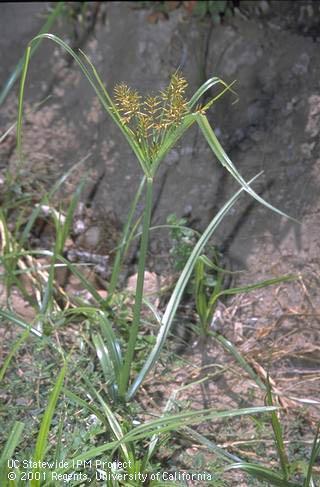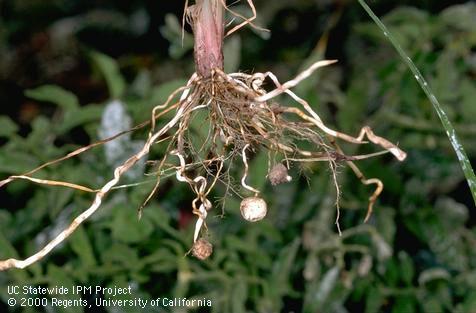Manage Weeds Before Planting

By Michael Harrelson
April showers bring May flowers… and weeds, lots of weeds. A weed is defined by the Weed Science Society of America as, “Any plant that is objectionable or interferes with activities or welfare of mankind”. It isn’t just a thistle, foxtail or crabgrass you recognize immediately as unwanted and pluck it out. A majestic oak on the edge of your property can be an integral part of your landscaping. An acorn sprouting up in the middle of your roses is a weed.
The most effective and economical way to approach a weed problem is to plan ahead and take steps to prevent an infestation before it overwhelms the perfectly planned landscape. Spring planting time is upon us and now is the time to think, not just about those beautiful summer blooms, but how to minimize weeds. Successful weed management should begin before new plants are set into the landscaping. Developing a weed management plan is as important as the landscape design itself. A site assessment is the first step. Before preparing the planting area and while weeds are visible, evaluate the soil and slope to anticipate where problems might occur. Make adjustments based on what you see. Is there a drainage issue that might move weed seeds during run off? Is there compaction that won’t support your prized petunia but is a perfect harbor for a weed seed to grow? Full sun plants won’t flourish in the shade but some weeds will. Does water pool in a low spot rather than infiltrating evenly? All of these problems should be corrected before you begin site preparation.
 Site preparation begins with the removal of existing weeds. The weeds must be controlled before the area is planted or you will be nurturing not only the landscape plants, but the weed seeds hidden and waiting for their moment to emerge. Hand pulling stubborn perennials and larger annual grasses will help. Hand pulling is an important practice but will not completely address the problem. Any effort to eliminate weeds in the planting area requires an integrated approach, utilizing a variety of weed control methods. If hand weeding and hoeing does not provide a satisfactory level of control, a non-selective translocated herbicide, where the active ingredient moves from the blades and leaves to the roots, can be used on the remaining annual grasses and broadleaf perennials. Non-selective contact herbicides (synthetic or organic) are also effective in controlling young annuals. Once those first weeds have been managed more will soon appear. Shallow cultivation of these young annuals, scraping the top one inch or less of soil with a shovel or hoe, will remove these. Immediately water the area after initial scraping to encourage those last remaining weed seeds to sprout. When the last weeds appear, repeat the shallow cultivation.
Site preparation begins with the removal of existing weeds. The weeds must be controlled before the area is planted or you will be nurturing not only the landscape plants, but the weed seeds hidden and waiting for their moment to emerge. Hand pulling stubborn perennials and larger annual grasses will help. Hand pulling is an important practice but will not completely address the problem. Any effort to eliminate weeds in the planting area requires an integrated approach, utilizing a variety of weed control methods. If hand weeding and hoeing does not provide a satisfactory level of control, a non-selective translocated herbicide, where the active ingredient moves from the blades and leaves to the roots, can be used on the remaining annual grasses and broadleaf perennials. Non-selective contact herbicides (synthetic or organic) are also effective in controlling young annuals. Once those first weeds have been managed more will soon appear. Shallow cultivation of these young annuals, scraping the top one inch or less of soil with a shovel or hoe, will remove these. Immediately water the area after initial scraping to encourage those last remaining weed seeds to sprout. When the last weeds appear, repeat the shallow cultivation.
When selecting plants don’t accidentally bring in weeds. Check your potted plants for weeds sprouting from the surface. Annual weeds removed by hand will be gone but perennial weeds may cause a recurring long-term problem and will probably necessitate an herbicide treatment. Some perennial weeds are highly invasive and should be avoided at all costs. The nutsedges, yellow and purple, which propagate underground, and field bindweed, which can sink its roots down to nine feet, can only be controlled chemically or with years of non-chemical methods. Keep your equipment and garden tools clean. Cleaning mowers, trimmers, hand tools and large garden implements will help reduce the introduction of new weeds. Soil amendments and potting mix can sometimes introduce weed seeds. Using only amendments certified by the US Composting Council (compostingcouncil.org/seal-of-testing-assurance/) will ensure a weed free product.
Appropriate plant selection can make it easier to manage weeds after planting. Woody plants, especially once they are established, are more tolerant of close cultivation. Herbaceous plants, including annuals, will require hand pulling of weeds. The use of borders will discourage weed growth into your planting bed. Employ the right irrigation method when setting up your landscape design. Drip or subsurface irrigation target the plants drip line and will put the water where it is most needed. The overspray of sprinklers will moisten areas away from the plant and encourage weeds to grow in empty spaces.
Get new plants established and growing as quickly as possible so that they can become competitive with the weeds. Consult a trusted source, such as the Master Gardener Hotline (858-822-6910), to learn about plant culture, fertilizing and irrigation schedules. Pay attention to the information on the nursery tag, especially with regard to light exposure. Adhere to the old garden adage, “The right plant for the right place”.
Mulch! Mulches suppress annual weeds by limiting the light required for them to establish themselves. Typically, mulch should be applied to a minimum depth of 2”. Three to 4” is often used because as mulch decomposes, the depth is reduced and weeds may begin to grow through. Replenish the mulch as it decomposes. The larger the particle used the deeper the layer required to be effective. A porous underlayment (plastic or fabric) can be used to further suppress any weed seeds left after site preparation. After a period of rain, some weeds will appear on top of the mulch layer but those can easily be removed with hand pulling.
Weeding does not have to be a full time job if a management plan is implemented in the early stages of design. Then, when those April showers do arrive, there will be the reward of bright flowers and colorful foliage instead of the dread of hours of weeding to separate those valued plants from those unwanted invaders.
Michael Harrelson has been a Master Gardener since 2012. He is currently the VP of Communications and writes on gardening for the Associations’ many print and social media platforms.

